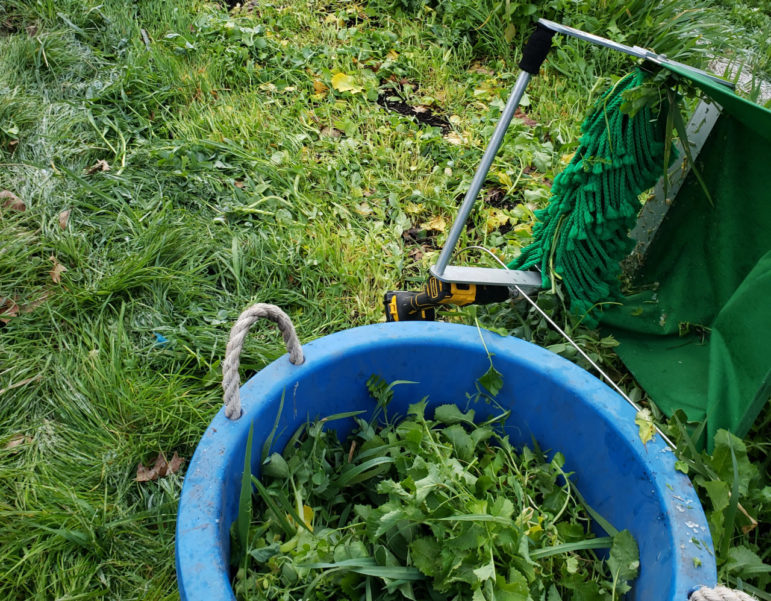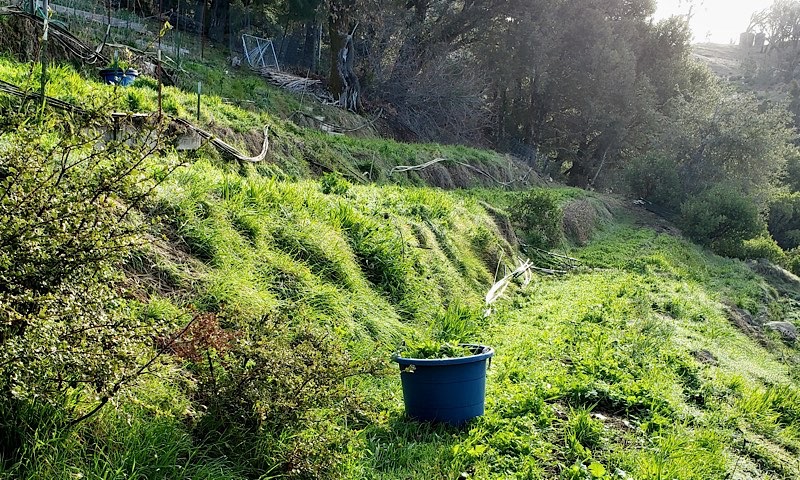This is our farm column from farmer Casey O’Neill. O’Neill is the owner operator of HappyDay Farms north of Laytonville, and a long time advocate for the cannabis community in Mendocino Co; more of his writing can be found here. The opinions expressed in this column are those of the writer. If you would like to submit a letter to the editor feel free to write to [email protected].
BELL SPRINGS 4/12/21 — This winter we started using the mechanical greens harvester, which we harvest salad mix with, for gathering cover crop for forage and for the “fermented plant juice” (FPJ) that will go into our compost teas over the course of the growing season. Like many things mechanical, shifting from hand-scythes to a mechanical harvester means that we can bring in forage in about a tenth of the time that it used to take. It has meant that the animals have gotten more fresh greens through the cold months, which feels good.
Before mowing the cover crop with the BCS flail mower, I’ll run the greens harvester to bring in the bulk of the biomass. We start early, while the dew is still on the plants and before the sun has hit them. We’ll dump a dozen totes onto a tarp for making FPJ and fill them back up to store for livestock forage over the next several days.

We layer the cover crop with sugar into a barrel, cutting and pounding the green matter to mix the sugar well and release the moisture stored within the plants.The sugar will help to draw the moisture out, and after a month or so we’ll squeeze off the thick syrup, to be diluted and used over the course of the season to encourage plant growth.
Working to produce fertility on farm is part of our practices, and we get a bit better at it every year.
Scaling up our FPJ production from 5-gallon buckets to 50-gallon barrels provides a strong basis, along with compost for our weekly tea regimens during the course of the season.
Preparation is key, as the time it takes to ferment the FPJ, coupled with the seasons during which the types of plants that we want to use are available means that we need to start early in the year. We want growing shoots of green plants in the spring for harvesting available nitrogen and growth hormones, so what we make now will carry us through the point in the season when the plants shift from vegetative growth to flowering.
We make the specific fermented fruit juices (FFJ) for feeding to flowering plants, following the basic idea that we want to feed sources that were harvested at the stage for which we are trying to feed. Ergo, we feed flowering plants and fruits to flowering plants.
We’ve had great success making FFJ out of the inevitable blown-out zucchinis of late-summer, and have also used banana peels to make an FFJ that supplemented potassium. We often use the sweepings from flowering cannabis plants to make a flower-feed FPJ, converting the unused plant matter into future fertility.
Garden waste and cover crop-forage growth are key for our fertility production and our participation in cycles of carbon sequestration. We use the harvested green matter to feed animals during the dry or muddy parts of the year, but we also rotate the animals to harvest and fertilize green pasture matter to encourage an increase in vegetative growth. This growth will sequester carbon and build organic matter in the soil, becoming richer and more abundant as the seasons march along.

There is an inherent trend in our land-management strategy for it to become more complex and interwoven as we deepen into the cycles. The more we learn and acquire equipment, the more able we are to participate at a higher level of activity and actuation.
The fecundity of the land is native and natural, yet can be supported and invigorated by human interaction.
We import compost, straw and amendments as needed based on soil tests. Our intensive plantings are managed for rapid rotation and continued production, maximizing the number of crops that can be harvested from a given space in the course of a year. Cover crops fill the gaps between food and medicine crops, although we are transitioning our cover crops to be edible and harvestable to increase availability of local produce and maximize harvest potential without sacrificing the benefits of keeping soil covered and root exudates producing for soil organisms.
As the soil improves in both crops and pasture, we notice the differences. It feels good to look back on the progression of the farm, to see how far we have come over the years. It is also important to look to the future and understand how far we have to go, for the work has just begun.
As always, much love and great success to you in your journey!
Casey O’Neill owns and runs HappyDay Farms, a small vegetable and cannabis farm north of Laytonville. He is a long time cannabis policy advocate, and was born and raised in the Bell Springs area. The preceding has been an editorial column. The Mendocino Voice has not necessarily fact-checked or copyedited this work, and it should be interpreted as the words of the author, not necessarily reflecting the opinions of The Mendocino Voice.




